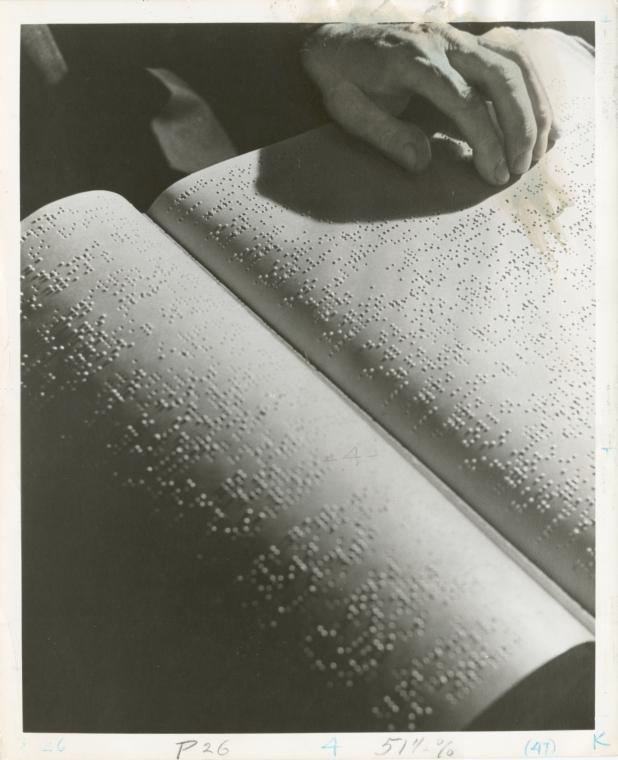Barrier-Free Library
The Birth of Braille
Most people read with their eyes. They might read a physical book or electronic text. Some people read with their ears, listening to audiobooks or Talking Books from the National Library Service. And some people read with their fingers.
January 4 marks the anniversary of the birth of Louis Braille (born 1809), inventor of the raised writing system that bears his name and is still used by visually impaired people to communicate.
Although many forms of raised writing were used before, during, and for a time, after Braille's life, his system endured due to its ease in writing and its simplicity. It has been readily adapted to modern times, thanks to transcription programs that can produce Braille output via computers using Braille printers and refreshable Braille displays.
Braille Timeline
1784: Valentin Haüy teaches a blind beggar, François Lesueur, to read, using wooden letters. Other written communication systems devised by blind people at the time included bent wire letters used by Christian Niesen, a tutor of a blind German student, and a series of pinpricks used by Maria Theresia von Paradis, a young blind girl who was a piano prodigy. Haüy operates a school for the blind and writes a landmark book An Essay On The Education Of The Blind. Haüy develops a system for embossing books for his students, consisting of raised letters.
Jan. 4 1809: Louis Braille is born.
1812: When he's three years old, Louis Braille is blinded in an accident while playing with his father's tools.
1819: Louis Braille is enrolled in the Paris school for the blind started by Valentin Haüy who was no longer running it. At this time, the school had 14 embossed books, too large and heavy for the youngest students to lift.
1824: Louis Braille unveils his raised dot writing system. Charles Barbier de la Serre, a soldier who had devised a "night writing artillery code" that uses dots and dashes, brought his code to the Royal Institution for Blind Children. Louis Braille had participated in a demonstration of this raised communication system. Having spent years trying to find a workable and efficient method of tactile writing, he realized he'd found the right means and adapted the code into the six dot cell writing system that's now known as Braille.
1829: Louis Braille publishes Method of Writing Words, Music, and Plain Songs by Means of Dots, for Use by the Blind and Arranged for Them.
Jan. 6, 1852: Louis Braille dies. He continued to tinker with his Braille system until his death.
1854: France adopts Braille as its official communications system for blind people.
1927: The National Braille Press is started in Boston, MA
1946: Nemeth Code, a special type of Braille used for math and science notations, is developed by Dr. Abraham Nemeth as part of his doctoral studies in mathematics.
1952: The Braille Authority of North America (BANA) accepts the Nemeth Code as the standard code for representing math and science expressions in Braille.

Further Reading
On the Web
History of Braille
Books in Accessible Formats
- Braille: Into the Next Millennium by Judith M. Dixon, 2000. DB 50969 (Download Only), BR 13188, 4 volumes.
- The Reading Fingers: Life of Louis Braille, 1809-1852 by Jean Roblin Translated from French. 1952. BR014555, 1 volume.
- Triumph over Darkness: The Life of Louis Braille by Leonard Bickel, 1988. BR017820, DB068015. [NYPL]
Sources of Braille materials
Braille at NYPL
- The Heiskell Library offers materials to borrow in a wide range of formats, including braille, talking books, and magazines, for users of all ages, as well as players and apps. Find out more about this location and its services here.
Read E-Books with SimplyE
 With your library card, it's easier than ever to choose from more than 300,000 e-books on SimplyE, The New York Public Library's free e-reader app. Gain access to digital resources for all ages, including e-books, audiobooks, databases, and more.
With your library card, it's easier than ever to choose from more than 300,000 e-books on SimplyE, The New York Public Library's free e-reader app. Gain access to digital resources for all ages, including e-books, audiobooks, databases, and more.
If you don’t have an NYPL library card, New York State residents can apply for a digital card online or through SimplyE (available on the App Store or Google Play).
Need more help? Read our guide to using SimplyE.

Comments
Timeline doesn't begin with Louis Braille??
Submitted by Jeff (not verified) on July 19, 2011 - 12:08pm
Thanks! I learned a lot while
Submitted by Rachelle Stein (not verified) on July 19, 2011 - 1:22pm